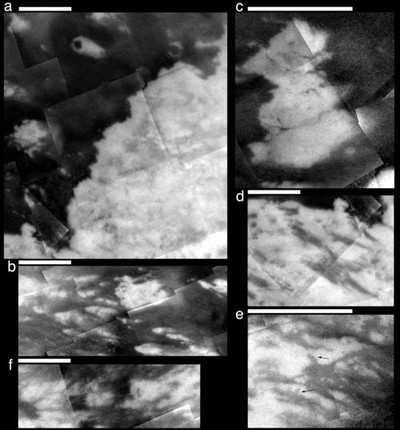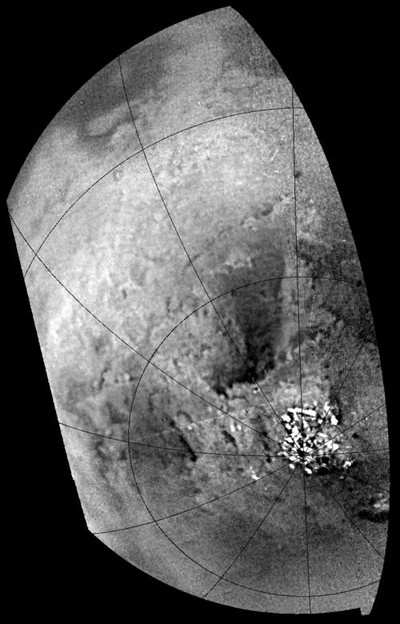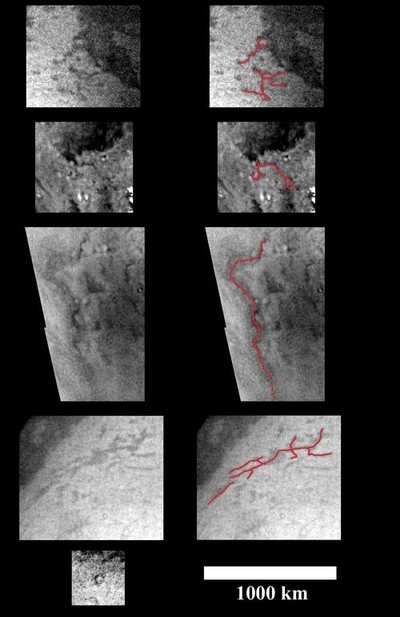Surface Appears Shaped By Same Sorts Of Forces Felt Here
Saturn's largest and hazy moon, Titan, has a surface shaped
largely by Earth-like processes of tectonics, erosion, winds, and
perhaps volcanism. The findings are published in this week's issue
of the journal Nature.

Titan, long held to be a frozen analog of early Earth, has
liquid methane on its cold surface, unlike the water found on our
home planet. Among the new discoveries is what may be a long river,
roughly 1,500 kilometers long (930 miles). Scientists have also
concluded that winds on Titan blow a lot faster than the moon
rotates, a fact long predicted but never confirmed until now.
Tectonism (brittle fracturing and faulting) has clearly played a
role in shaping Titan's surface. "The only known planetary process
that creates large-scale linear boundaries is tectonism, in which
internal processes cause portions of the crust to fracture and
sometimes move either up, down or sideways," said Dr. Alfred
McEwen, Cassini imaging team member from the University of Arizona,
Tucson. "Erosion by fluids may accentuate the tectonic fabric by
depositing dark materials in low areas and enlarging fractures.
This interplay between internal forces and fluid erosion is very
Earth-like."

Cassini images collected during close flybys of the moon show
dark, curving and linear patterns in various regions on Titan, but
mostly concentrated near the south pole. Some extend up to 1,500
kilometers (930 miles) long. Images from the European Space
Agency's Huygens probe show clear evidence for small channels a few
kilometers long, probably cut by liquid methane. Cassini imaging
scientists suggest that the dark, curved and linear patterns seen
in the Cassini orbiter images of Titan may also be channels, though
there is no direct evidence for the presence of fluids. If these
features are channels, it would make the ones near the south pole
nearly as long as the Snake River, which originates in Wyoming and
flows across four states.
Since most of the cloud activity observed on Titan by Cassini
has occurred over the south pole, scientists believe this may be
where the cycle of methane rain, channel carving, runoff, and
evaporation is most active, a hypothesis that could explain the
presence of the extensive channel-like features seen in this
region.
In analyzing clouds of Titan's lower atmosphere, scientists have
concluded that the winds on Titan blow faster than the moon
rotates, a phenomenon called super-rotation. In contrast, the jet
streams of Earth blow slower than the rotation rate of our
planet.
"Models of Titan's atmosphere have indicated that it should
super-rotate just like the atmosphere of Venus, but until now there
have been no direct wind measurements to test the prediction," said
Cassini imaging team member Dr. Tony Del Genio of NASA's Goddard
Institute for Space Studies, in New York. DelGenio made the first
computer simulation predicting Titan super-rotation a decade
ago.
Titan's winds are measured by watching its clouds move. Clouds
are rare on Titan, and those that can be tracked are often too
small and faint to be seen from Earth. Ten clouds have been tracked
by Cassini, giving wind speeds as high as 34 meters per second
(about 75 miles per hour) to the east -- hurricane strength -- in
Titan's lower atmosphere. "This result is consistent with the
predictions of Titan weather models, and it suggests that we now
understand the basic features of how meteorology works on slowly
rotating planets," said Del Genio.
"We've only just begun exploring the surface of Titan, but
what's struck me the most so far is the variety of the surface
patterns that we're seeing. The surface is very complex, and shows
evidence for so many different modification processes," said Dr.
Elizabeth Turtle, Cassini imaging team associate in the Lunar and
Planetary Laboratory at the University of Arizona, Tucson and
co-author of one of the papers in Nature.

"Throughout the solar system, we find examples of solid bodies
that show tremendous geologic variation across their surfaces. One
hemisphere often can bear little resemblance to the other,”
said Dr. Carolyn Porco, Cassini imaging team leader, Space Science
Institute, Boulder, CO. "On Titan, it's very likely to be this and
more."
These results are based on Cassini orbiter images of Titan
collected over the last eight months during a distant flyby of the
south pole and three close encounters of Titan's equatorial region.
Cassini cameras have covered 30 percent of Titan's surface, imaging
features as small as 1 to 10 kilometers (0.6 to 6 miles). Cassini
is scheduled to make 41 additional close Titan flybys in the next
three years.
 ANN's Daily Aero-Linx (05.06.25)
ANN's Daily Aero-Linx (05.06.25) ANN's Daily Aero-Term (05.06.25): Ultrahigh Frequency (UHF)
ANN's Daily Aero-Term (05.06.25): Ultrahigh Frequency (UHF) ANN FAQ: Q&A 101
ANN FAQ: Q&A 101 Classic Aero-TV: Virtual Reality Painting--PPG Leverages Technology for Training
Classic Aero-TV: Virtual Reality Painting--PPG Leverages Technology for Training Airborne 05.02.25: Joby Crewed Milestone, Diamond Club, Canadian Pilot Insurance
Airborne 05.02.25: Joby Crewed Milestone, Diamond Club, Canadian Pilot Insurance





